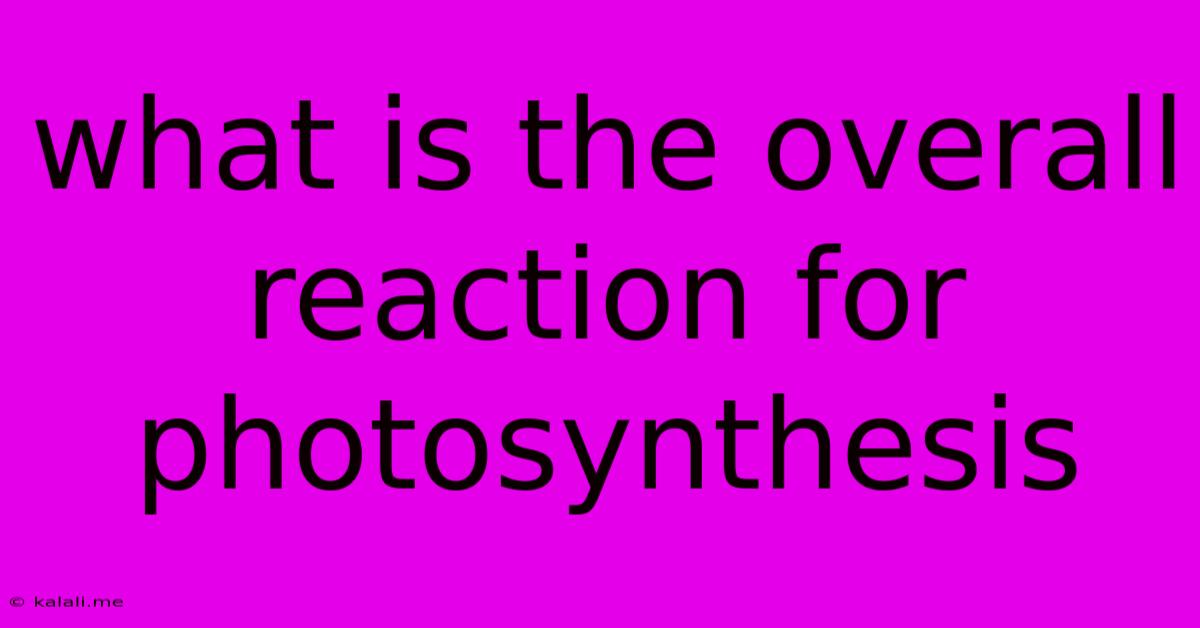What Is The Overall Reaction For Photosynthesis
Kalali
May 10, 2025 · 3 min read

Table of Contents
What is the Overall Reaction for Photosynthesis? A Deep Dive into the Process
Photosynthesis, the remarkable process by which green plants and some other organisms use sunlight to synthesize foods from carbon dioxide and water, is crucial for life on Earth. Understanding its overall reaction is key to grasping its significance. This article will break down the overall equation, explore the individual stages, and touch upon the importance of this fundamental biological process.
The overall reaction of photosynthesis can be summarized by a single, deceptively simple equation:
6CO₂ + 6H₂O + Light Energy → C₆H₁₂O₆ + 6O₂
This equation tells us that six molecules of carbon dioxide (CO₂) react with six molecules of water (H₂O) in the presence of light energy to produce one molecule of glucose (C₆H₁₂O₆), a simple sugar, and six molecules of oxygen (O₂). This glucose then serves as the plant's primary source of energy and building block for other organic molecules. Oxygen is released as a byproduct. Let's delve deeper into the two main stages involved.
The Two Stages of Photosynthesis: Light-Dependent Reactions and Light-Independent Reactions (Calvin Cycle)
Photosynthesis isn't a single-step process. It's actually comprised of two interconnected stages:
-
Light-Dependent Reactions: These reactions occur in the thylakoid membranes within the chloroplasts. Light energy is absorbed by chlorophyll and other pigments, exciting electrons to a higher energy level. This energy is then used to split water molecules (photolysis), releasing oxygen as a byproduct. The energy from these excited electrons is also used to generate ATP (adenosine triphosphate), the cell's energy currency, and NADPH, a reducing agent. These ATP and NADPH molecules are crucial for the next stage. Understanding the specific roles of Photosystem I and Photosystem II is essential for a complete understanding, but falls outside the scope of this overall reaction summary.
-
Light-Independent Reactions (Calvin Cycle): These reactions take place in the stroma, the fluid-filled space surrounding the thylakoids. The ATP and NADPH generated during the light-dependent reactions provide the energy and reducing power needed to convert carbon dioxide into glucose. The Calvin cycle is a cyclical series of reactions that uses carbon dioxide from the atmosphere, along with ATP and NADPH, to synthesize glucose through a series of enzyme-catalyzed steps. Key enzymes like RuBisCO play vital roles in this carbon fixation process. This stage doesn't directly require light, although it relies on the products of the light-dependent reactions.
The interplay between these two stages is what allows plants to harness solar energy and convert it into the chemical energy stored within glucose.
The Significance of Photosynthesis: More Than Just Oxygen
While the production of oxygen is vital for most life on Earth, the importance of photosynthesis extends far beyond that. This process forms the base of most food chains, providing energy for virtually all ecosystems. It also plays a critical role in regulating the Earth's atmosphere by removing carbon dioxide, a greenhouse gas, and releasing oxygen.
Conclusion: A Fundamental Process
The overall reaction of photosynthesis, 6CO₂ + 6H₂O + Light Energy → C₆H₁₂O₆ + 6O₂, is a deceptively simple representation of a remarkably complex and vital biological process. Understanding the two stages, the light-dependent and light-independent reactions, provides a more complete picture of how plants capture solar energy and convert it into chemical energy in the form of glucose. This process is fundamental to the health of our planet and the survival of all life on Earth.
Latest Posts
Latest Posts
-
How Many Teaspoons In A Pound Of Sugar
Jul 12, 2025
-
How Do You Pass Level 12 On Bloxorz
Jul 12, 2025
-
How Far Is 0 4 Miles To Walk
Jul 12, 2025
-
What Is 20 Percent Of 800 000
Jul 12, 2025
-
Words That Start With Y In Science
Jul 12, 2025
Related Post
Thank you for visiting our website which covers about What Is The Overall Reaction For Photosynthesis . We hope the information provided has been useful to you. Feel free to contact us if you have any questions or need further assistance. See you next time and don't miss to bookmark.